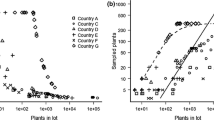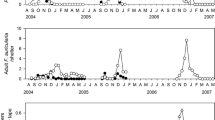Abstract
In the present study, the distribution of the Horse Chestnut Scale insectPulvinaria regalis Canard in Germany in the years 1996 to 1998 and tendencies in the variation of infestation levels during the past three years were investigated by a survey. A questionnaire was sent to the offices for green areas and environmental affairs of 121 cities in Germany with a population exceeding 75.000 citizens. Additional observations by the authors were also taken into consideration. A comparison to data from 1995 was conducted. In the year 1998, this arboricultural pest occurred in 34 cities (15 in 1995) and could be found in the areas of the Rhineland and the Ruhr-Valley, from Bonn in the south up to Münster (Westphalia) in the north and from Aachen in the west to Hagen and Dortmund in the east.P. regalis could also be detected in Offenbach and Frankfurt a. M., It also occurred southward along the rivers Rhine and Neckar in the cities of Mainz, Ludwigshafen, Freiburg and Stuttgart. The most southern point whereP. regalis was detected in July 1998 was Zürich in Switzerland. The first occurrence of the 19 new observed infestations withP. regalis took place in six instances before 1995, eight in 1995, three in 1996, and one each in 1997 and 1998. The investigations about tendencies in the variation of infestation levels revealed a decrease in scale numbers only in the cities where Horse Chestnut Scales have been observed first in Germany. On the other hand, almost every place located further away from these infestation sites showed a population increase ofP. regalis. Constant infestation levels over the past three years could be found in only two cities. In most cases lime, maple and horse chestnut trees were the host plants of this scale insect.
Similar content being viewed by others
Literature
Borror, D. J.;Delong, D. M., 1971: An introduction to the study of insects. Holt, Rinehart & Winston, New York, 324 PP.
Braun, S.;Flückiger, W.;Oertli, J. J., 1981: Einfluß einer Autobahn auf den Befall von Weißdorn (Crateagus monogyna) mit Aphis pomi. Mitt. Dsch. Ges. Allg. Angew. Ent.5, 138–139.
Canard, M., 1968: Un noveauPulvinaria (Hom. Coccidea) nuisible aux arbres d’alignement dans la région parisienne. Ann. Soc. Ent. Fr. (N.S.),4(4), 951–958.
Cornwell, P. B., 1960: Movements of the vectors of virus diseases of cacao in Ghana. Bull. Ent. Res.51, 175–201.
Dalchow, J.;Bathon, H., 1995: Die SchildlausPulvinaria regalis Canard neu in Hessen (Homoptera: Coccidae): Hessische Faunistische Briefe14(2), 29–31.
De Meirleire, H., 1984: Cochenilles pulvinaires des arbres d’ornement: deux espèces à ne pas confondre. Phytoma354, 37–38.
Faber, T.;Sengonca, C., 1994: Freilanduntersuchungen über die Biologie der NapfschildlausPulvinaria regalis Canard an Park-und Alleebäumen im Bonner Raum. Mitt. BBA (Berlin-Dahlem)301, 475.
Faber, T.;Sengonca, C., 1995: Die Wollige Napfschildlaus an Park-und Alleebäumen in rheinischen Städten und Möglichkeiten einer biologischen Bekämpfung. Lehr-und Forschungs-schwerpunkt «Umweltverträgliche und standortgerechte Landwirtschaft”, 9. wiss. Fachtagung «Herausforderung für den Pflanzenschutz”, Landw. Fak., Univ. Bonn, Forschungber.25, 59–67.
Faber, T.;Sengonca, C., 1996: Verbreitungsgebiet der erst in jüngerer Zeit nach Deutschland eingeschleppten Wolligen NapfschildlausPulvinaria regalis Canard an Park-und Alleebäumen. Gesunde Pflanzen48(6), 221–223.
Faber, T.;Sengonca, C., 1997: Laboruntersuchungen zur Lebensdauer und Fruchtbarkeit vonCoccophagus scutellaris (Dalm.) (Hym., Aphelinidae) als Parasitoid der Wolligen NapfschildlausPulvinaria regalis Canard (Hom., Coccidae). Gesunde Pflanzen49(3), 84–88.
Harris, K. M., 1970: Horse chestnut scale. Arbor. Ass. J.1, 257–262.
Hodgson, C. J., 1994: The scale insect family Coccidae: An identification manual to genera. 1. Aufl., S. 4, CAB Intern., Cambridge, 639 pp.
Kozar, F.;Guignard, F.;Bachmann, E.;Mani, E.;Hippe, C., 1994: The scale insect and whitefly species of Switzerland (Homoptera: Coccoidea and Aleyrodoidea). Mitt. Schweiz. Ento. Ges.67, 151–161.
Kreul, K., 1996: Zur Schildlaus-Fauna von Köln (Hemiptera-Homoptera: Coccina). Decheniana-Beihefte (Bonn)35, 175–194.
Malumphy, C., 1988: Woolly scales in Britain. Garden, UK113, 337–339.
Merlin, J.;Pasteels, J.-M., 1989: La Pullulation des Cochenilles Pulvinaires en Milieu urbain: état de la situation et moyens de lutte. In: Actes du colloque “Gerer la nature?”. Trav. Cons. Nat.15, 607–618.
Merlin, J.;Gregoire, J.-C.;Domans, M.;Speight, M. R.;Pasteels, J. M.;Verstraeten, C., 1988: Preliminary comparison of two scale insects on broadleaved trees in Western Europe. Med. Fac. Landbouww. Rijksuniv. Gent53(3a), 1153–1158.
Moraal, L. G., 1988: Landelijke inventarisatie insektenaantastingen: Invasie van dopluizen in Nederlandse steden. Tuin u. Landschap10(14), 20–21.
Reeves, A., 1988: Myercough College, Myerscough Hall, Bils-borrow, Preston, Lancashire, PR3 0RY. (pers. com.)
Schmitz, G., 1997: Zum Wirtspflanzenspektrum vonPulvinaria regalis Canard (Hom., Coccidae). Gesunde Pflanzen49(2), 43–46.
Sengonca, C.;Faber, T., 1995: Beobachtungen über die neu eingeschleppte SchildlausartPulvinaria regalis Canard an Park- und Alleebäumen in einigen Stadtgebjeten im nördlichen Rheinland. Z. PflKrankh. PflSchutz102(2), 121–127.
Sengonca, C.;Faber, T., 1996: Studies on developmental stages of the horse chestnut scale insect,Pulvinaria regalis Canard (Hom., Coccidae), in the open land and in the laboratory. Anz. Schädlingskde, Pflanzenschutz, Umweltschutz69, 59–63.
Speight, M. R., 1984: Tree Pests—11 Horse chestnut scale,Pulvinaria regalis Canard. Arboric. J.8, 287–290.
Speight, M. R., 1984: The impact of leaf-feeding by nymphs of the horse chestnut scalePulvinaria regalis Canard (Hom. Coccidae), on young host trees. J. Appl. Ent.112, 389–399.
Speight, M. R., 1994: Reproductive capacity of the horse chestnut scale insect,Pulvinaria regalis Canard (Hom., Coccidae). J. Appl. Ent.118, 59–67.
Speight, M. R.;Nicol, M., 1984: Horse chestnut scale—A new urban menace? New Scientist1404, 40–42.
Speight, M. R.;Nicol, M., 1985: Horse chestnut scale—Another problem for urban trees? Antenna9(4), 175–178.
Speight, M. R.;Hails, R. S.;Gilbert, M.;Foggo, A., 1998: Horse chestnut scale (Pulvinaria regalis) (Homoptera: Coccidae) and urban host tree environment. Ecology79(5), 1503–1513.
Washburn, J. O.;Washburn, L., 1984: Active aerial dispersal of minute wingless Arthropods: Exploitation of boundary-layer velocity gradients. Science23, 1088–1089.
Author information
Authors and Affiliations
Rights and permissions
About this article
Cite this article
Sengonca, C., Arnold, C. Survey on the distribution of the Horse Chestnut ScalePulvinaria regalis Canard (Hom., Coccidae) in Germany in the years 1996 to 1998. Anz. Schadlingskde., Pflanzenschutz, Umweltschutz 72, 153–157 (1999). https://doi.org/10.1007/BF02767136
Issue Date:
DOI: https://doi.org/10.1007/BF02767136




